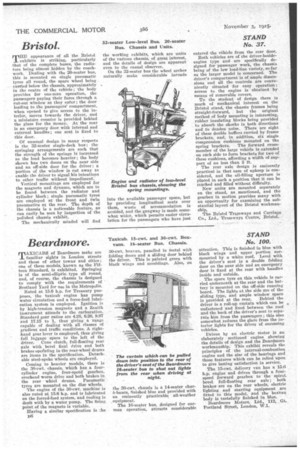Bristol.
Page 12

If you've noticed an error in this article please click here to report it so we can fix it.
MHE appearauce of all the Bristol exhibits is striking, particularly that of the complete buses, the radiators being almost hidden by the coachwork. Dealing with the 20-seater bus, this is mounted on single pneumatic tyres all round, the spare wheel being carried below the chassis, approximately in the centre of the vehicle ; the body provides for one-man operation, the passengers paying their fares through a cut-nut window as they enter ; the door leading to the passengers' compartment. when opened to give access to the interior, moves towards the driver, and a miniature counter is provided behind the glass for the money. At the rear is an emergency door, with internal and external handles; one seat is fixed to this door.
Of unusual design in many respects is the 32-seater single-deck bus; the springing . arrangements are such that the strength of the springs is increased as the load becomes heavier ; the body shown has two doors on the near side and an off-side door for the driver ; a portion of the window is cut away to enable the driver to signal his intentions to other traffic without impediment.
Vertical mountings are employed for the magneto and dynamo, which are to be found between the radiator and cylinder block ; single pneumatic tyres are employed at the front and twin pneumatics at the rear. The depth of the chassis is a noticeable feature, as eau .easily be seen by inspection of the polished chassis exhibit.
The mechanically minded will find the working exhibits, which are units of the various chassis, of great interest, and the details of design are apparent even to the casual observer.
On the 32-seater bus the wheel arches naturally make considerable inroads into the available passenger space, but by providing longitudinal seats over them, waste of accommodation is avoided, and the gangway is made somewhat wider, which permits easier circulation for the passengers who have just entered the vehicle from the rear door.
Both vehicles are of thedriver-besideengine type and are specifically designed for passenger work, the chassis being of the low load-line variety, so far as the larger model is concerned. The driver's compartment is of ample dimensions and all the controls are conveniently situated -for easy operation; access to the engine is obtained by means of removable covers.
To the student of design there is much of mechanical interest on the Bristol stand, the chassis frames being straight-forward, but the original method of body mounting is interesting, rubber insulating blocks being provided to absorb the shocks in both directions and to deaden noise, There are eight of these double buffers carried by frame brackets, and, in addition, six single compression cushions mounted on the
spring brackets. The forward crossmember of the large vehicle is extended on each side to form brackets for two of these cushions, affording a width of support of no less than 5 ft.
The rear axle design is eminently practical in that ease of upkeep is considered, and the oil-filling aperture is placed in such a position that it can be reached and filled without difficulty.
blew units are mounted separately on the stand, as mentioned, and the gearbox in motien provides many with an opportunity for examining the substantial layout of the Bristol workmanship.
The Bristol Tramways and Carriage Co., Ltd., Tramways Centre, Bristol.
















































































